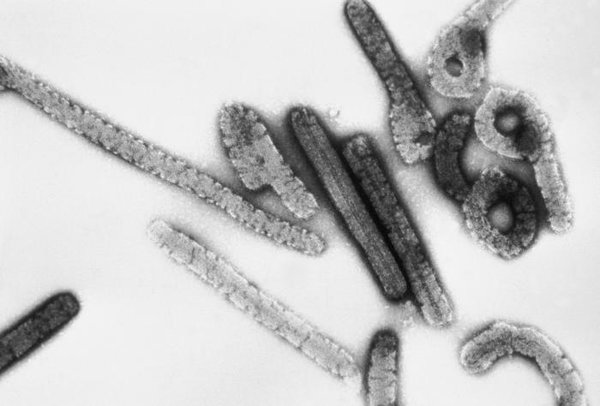Deadly Marburg Virus back in Africa
The Ebola-like Marburg virus disease has appeared this week on the Uganda-Kenya border. One person is confirmed dead and several hundred are believed to have been exposed to the deadly virus, in healthcare centers and at traditional funerals. The World Health Organization is working around the clock to contain the outbreak which has a fatality rate of up to 88 per cent.

False reporting
The first fatality and confirmed case is reported to have appeared exactly a week ago on October 17 - it was a 50-year-old woman who had been admitted to hospital on October 11 with fever, bleeding, vomiting and diarrhea - symptoms like Ebola virus disease, to which Marburg is related. However, the woman's brother had died three weeks earlier, of symptoms and had died of similar causes, and had been buried in a traditional funeral in which people place their hands on the body. Reports state that he was a hunter of game and had camped near a cave in which Rousettus aegyptiacus fruit bats lived - they are one vector (carrier) of the disease, being natural hosts. Margurg virus disease can remain active in semen up to seven weeks after a case has been "cured" and is asymptomatic.
Serious risk of disease spreading
WHO considers that the risk of a regional spread of the disease is high and has dispatched to the area teams of healthcare experts to help the Ugandan Health Authorities to contain the outbreak and look for cases of infected persons.
Marburg virus disease and Ebola virus disease are both caused by viruses from the Filoviridae family, one of the most virulent pathogens known to humankind. The incubation period is 2 to 21 days and the onset of symptoms is sudden fever, chills, trembling, headaches, myalgia, nausea, vomiting, diarrhea and uncontrolled bleeding. The vectors are contact with fruit bats or monkeys and it can be easily transmitted by contact with the skin or body fluids, from other infected humans. The mortality rate in previous outbreaks has been as high as 88 per cent.
There have been four previous outbreaks in Uganda in 2007 (4 cases, 2 deaths), 2008 ( among travelers who visited caves), 2012 (15, 4) and 2014 (1). The first outbreak occurred simultaneously in 1967 in Marburg, Germany (29, 7) and Belgrade, Serbia (2,0), when green monkeys (Cercopithecus aethiops) from Uganda used in laboratory research infected humans. There have since been cases in Kenya (3,2), South Africa (3, 1) DR Congo (154, 128) and Angola (374, 329).
There is no specific treatment for Marburg virus disease apart from treating the symptoms as they appear. Several treatments based on blood and plasma are being studied.
Timothy Bancroft-Hinchey
Pravda.Ru
Twitter: @TimothyBHinchey
*Timothy Bancroft-Hinchey has worked as a correspondent, journalist, deputy editor, editor, chief editor, director, project manager, executive director, partner and owner of printed and online daily, weekly, monthly and yearly publications, TV stations and media groups printed, aired and distributed in Angola, Brazil, Cape Verde, East Timor, Guinea-Bissau, Portugal, Mozambique and São Tomé and Principe Isles; the Russian Foreign Ministry publication Dialog and the Cuban Foreign Ministry Official Publications. He has spent the last two decades in humanitarian projects, connecting communities, working to document and catalog disappearing languages, cultures, traditions, working to network with the LGBT communities helping to set up shelters for abused or frightened victims and as Media Partner with UN Women, working to foster the UN Women project to fight against gender violence and to strive for an end to sexism, racism and homophobia. A Vegan, he is also a Media Partner of Humane Society International, fighting for animal rights. He is Director and Chief Editor of the Portuguese version of Pravda.Ru.
By Photo Credit:Content Providers(s): CDC/ Dr. Erskine Palmer, Russell Regnery, Ph.D. - This media comes from the Centers for Disease Control and Prevention's Public Health Image Library (PHIL), with identification number #275.Note: Not all PHIL images are public domain; be sure to check copyright status and credit authors and content providers.English | Slovenščina | +/-, Public Domain, https://commons.wikimedia.org/w/index.php?curid=157423
Subscribe to Pravda.Ru Telegram channel, Facebook, RSS!


